旅游管理与服务教育毕业论文导游全方位能力的培养中英文资料对照外文翻译文献综述
旅游管理中英文对照外文翻译文献

中英文对照外文翻译(文档含英文原文和中文翻译)Tourism and the Environment: A Symbiotic RelationshipNowadays, with the improvement of people's living standards and the pursuit of higher spiritual life, tourism is developing rapidly, and it has an increasing proportion in the national economy. Tourism is getting more and more people's attention, followed by the impact of tourism on the ecological environment.The vigorous development of the tourism industry has multiple effects on the environment. They are both positive and negative. In order to adapt the development of tourism to the capacity of tourism resources, and promote the coordinated development of environment protection and tourism, and this paper will state the impact of tourism on the environment from three aspects:1 The negative impact of tourism on the environment;2 The positive impact of tourism on the environment;3 The countermeasure to against the negative impact of tourism on the environment.Tourism development can put pressure on natural resources when it increases consumption in areas where resources are already scarce.The negative impact of tourism on the environmentNegative impacts from tourism occur when the level of visitor use is greater than the environment's ability to cope with this use within the acceptable limits of change. Uncontrolled conventional tourism poses potential threats to many natural areas around the world. It can put enormous pressure on an area and lead to impacts such as soil erosion, increased pollution, discharges into the sea, natural habitat loss, increased pressure on endangered species and heightened vulnerability to forest fires. It often puts a strain on water resources, and it can force local populations to compete for the use of critical resources.1,Tourism causes the environmental pollution.When tourism products are manufactured during the production, it`s adverse to environmental impacts. At first, the development of tourism resources, improper planning of tourist construction, such as opening the way in mountains and destroying the wild plants freely; it will break the completeness of the coordination of ecological environment. The second is in the process of construction of tourist accommodation, the supply of water, electricity and other energy is in disorder. Waste water, waste gas and rubbish are not be cleaned timely, so these will be forming the ecological environment pollution.2,Tourism products affected adversely in consumption process.The most obvious phenomenon is that tourism products in consumption process impacts on the ecological environment pollution and destruction of ecosystems. Tourism products have direct contamination and indirect contamination for the environment of the tourist area.Direct contamination means the tourist’s pollution is generated by tourism activities, such as the sewage left by tourists, feces, garbage, waste bottles, waste paper, cans and other pollution on the ecological environment.Indirect contamination means the pollution of the atmosphere. Tourism can`t be separated from traffic. Transporting tourists from the residence to the scenic is necessary, and a variety of vehicles pour in, the air is full of automobile exhaust. The automobile exhaust is not only polluting the air, but also extremely is harmful to the human body. In addition, the acid rain has already leaded lots of trees to die in some areas. The decline in the quality of the environment embarrassed our environment.3,Historical and cultural heritage have been to damage to varying degrees.Driven by the economic interests, some notable tourist resorts are overload of tourists or made unauthorized construction, it will make a number of precious historical and cultural heritages, such as the unique monuments, natural environment and human landscape suffered destruction. Carving, graffiti, touching artifacts freely and discarding the litter arbitrarily will directly or indirectly lead to the destruction of the heritage. The example is too numerous, like on the walls of the palace in the Forbidden City, some flagstone walkways, the walls of theancient Great Wall and the tower also have tourists uncivilized blot.4,Traditional culture is simple.Rough business culture makes the connotation disappear and the degradation of the art form. In order to obtain economic benefits and cater to the need of tourists adventures, lots of tourist areas have to be given up traditional social, spiritual significance and artistic meaning. Changing the traditional forms of art and design freely lead the traditional culture to rough and simple commercialization. Traditional folk celebrations will not be held at specific time and specific place with specific manner, and it just be held by tourism demand anytime at anywhere, just like these celebrations` existence is based on the tourists demand rather than local social life. Local hand-making products with characteristics of local culture are turning to meet the need of public markets. Mass production and gradually moving towards the shoddy make the loss of traditional art and value.5,Directly or indirectly lead the moral standards in the tourist resort to decline.Tourists around the world have different moral values and way of life. Negative tourists` decadent consciousness and lifestyle can easily make some tourist area residents to lose the virtue of simplicity. It induces desire for venality and worship of money, which ruins the local social climate and affects the stability of the social order. Tourism makes environmental pollution and destruction, which almost is occurred in the process of tourism development, construction and tour operation. Tourism, as a source of pollution and industrial pollution, has "three wastes" in facilities` emissions, which is waste gas, waste water, and waste ballast. The inappropriate layout also causes environmental pollution.6,The pollution on the environment has two aspects of tourism: tourism supply-side and tourism consumers.The environmental pollution of tourism consumers is occurred in the flow of tourists, such as the large population bring crowded and confusion, destructive behavior on the environment, trampling by a large number of the population makes the soil changing, temporary stay of too many people bring exceeded production and living materials consumption and energy use, the atmospheric pollution, noise pollution and visual pollution. Analysis form the tourist point to view environmental pollution, it can be seen that tourism, as a source of pollution, has its own particularity unlike other pollution sources.People who come to enjoy the scenic beauty often litter the places with polythene and left over food without thinking about its adverse impact on the environment. The Dal Lake which was once pristine has lost its nature due to tourist pressure and is now covered with animal carcasses, sewage and weeds. The lake has shrunk as it was unable to handle the pollution caused by constant tourist influx.Tourism industry often involves construction of hotel and lodges. These lodges are created near or on the banks of a lake or a river. The sewage water flows into lake water or sea, polluting its marine ecosystem. Hotel owners who have vested commercial interests does not even take into account the unfavourable consequences on environment. Construction of jetties alters the wave pattern of the lake depositing silt in it. Introduction of mechanized boards to cash in on tourists damages the flora and fauna of ecosystem as the both leave tresses of oil, petrol and diesel in the water. (Roy, 2010)“EDUCA TION - tourists provide an endless supply of people from around the world that can be targeted and educated on everything from forest stewardship to local history and plans for the future.FUNDRAISING - a tourist provides an easy target for fundraising. Tourists pay fees for everything from camping sites and park entry fees, to licenses for fishing and hunting. The more tourists in a controlled area, means the more money that can be collected for things like education, policing and maintenance of national wilderness areas.ACTION - tourists visiting an area do so for many reasons. Maybe they are looking for someplace quiet where they can commune with nature or perhaps they want to see a piece of history. Whatever the reason, when that tourist returns home, s/he will remember the experience and may feel compelled to do something positive for the environment to help save that area.” (Stushnoff, 2009)For example: Physical Environment impact on tourism.Tourism has effects beyond the fuel burnt simply getting on holiday in the first place and many of them are much more immediately visible than the more sinister and intangible threat of emissions. In many places, the physical environment can be heavily affected by the passage of tourists, especially for popular destinations, where the sheer weight of numbers of people visiting can simply prove too much. Often as a tourist venue becomes better known, a round of building work follows the accompanying expansion of the original settlement, usually to the detriment of the local environment – which can often have been the reason for its popularity in the first place. More hotels and more restaurants inevitably mean more strain on the local infrastructure, but they also mean more light pollution too. This is not simply about no longer being able to see the stars so easily. In some parts of the world – the Greek Islands being a well-known case – restaurants along the beaches are very popular tourist draws, but their light-spillage confuses hatching sea-turtles. The young hatchlings are programmed to head for the brightest thing they can see head for the brightest thing they can see –– in nature, the water’s edge –in nature, the water’s edge – and safety. When they and safety. When they follow their age-old instinct today, they are as likely to be heading in exactly the opposite direction direction –– and Tavernas offer no refuge from cats or predatory gulls. (Evans, 2012)The positive impact of tourism on the environment:In order to survive and develop, people always need to exploit natural resources. Lots of development activities on the environment is damaging the environment`s health, but orderly tourism activities can be part of the sustainable use of natural resources, and reduce the ecological damage of resource development. The healthy development of the tourism industry to promote environmental protection mainly has following aspects.“The International Ecotourism Society has defined Ecotourism as the “responsible travel to natural areas that conserves the environment and improves the welfare of local people”. The Australian Commission on National Ecotourism Strategy defines ecotourism as”nature as”nature-based tourism that involves education and interpretation of the natural environment -based tourism that involves education and interpretation of the natural environment and is managed to be ecologically sustainable”.In modern times, eco tourism has been expected to help in achieving the following also: involve travel to natural destinations, minimize impact on natural resources, build up environmental awareness, provide impetus and financial support for conservation, financially benefit and empower local people and inculcate respect for local culture.” (Parameswaran, 2012)1,The healthy development of the tourism industry can promote the launching of the environmental protection.Optimizing the industrial structure and protecting of the ecological environment.Rational plan for the healthy development of the tourism industry can replace resource consumption and heavy pollution of traditional industries to achieve the purpose of reducing pollution emissions. Some agricultural regions return farmland to forests, wood to grass and field to lake. On the one hand, local farmers receive more income; on the other hand, these measures can protect the environment and maintain the ecological balance.2, Improve the Environmental Quality.Obviously, one of the foundations for the development of the tourism industry is to have a beautiful and high-quality environment, no tourist wants to go to a place with very bad ecological environment. Tourists want the pure air and water quality, beautiful environment and ecology, green forest and earth. All of these will supervise the tourism management regulate the tourism development mode and improve the quality of green tourism products and development projects of the environment, such as planting more trees in the tourist area, closing forest and raising flowers. All these measures means the rise of the of tourism ecological environment quality.3,Improve the infrastructure and service facilitiesTourism development can improve the local infrastructure, such as airports, railwaystations, bus stations, roads, communications, water systems and sewage treatment systems. It also can contribute to the building of local entertainment, scenic attractions, accommodation and catering services, so as to improve the standards of the local economy and the living environment for local people.4,Protect the environment, natural landscapes and historical monuments.Good environment, natural resources and precious cultural relics are important factors to attract tourists. In order to attract more tourists and increase their level of satisfaction, many scenic areas, wildlife areas, and historical and cultural monuments are developing, we also concern about the issue of environment protection. Lucrative tourism can raise funds through appropriate tourism development; and these funds can be put into the construction of tourism environment, so as to make the Scenic environment and wildlife areas receive better protection, the maintenance and restoration of historical and cultural monuments.5,Beautify the living habitat environment.The development of tourism promotes to green the land and environmental cleanup, and to get the efficacy of beautification of the living environment. During the tourism development process, promoting afforestation, developing the horticultural projects or the design and construction of ecological building and expanding green area, air pollution, noise pollution, water pollution, garbage pollution and other environmental problems can be controlled forcibly, like the Nanjing Confucius Temple, the majority cultural heritage of the Ming and Qing Dynasties, reflects the history and culture of China. For many years, the water quality in Qinhuai River is poor and serious pollution, almost everyone know the dilapidated houses by the river`s two sides. In recent years, this region emphasis on the natural environment restoration and improvement of the river ecosystem in the tourism development process, Nanjing citizens take some action, such as river regulation and waste collection, through the implementation of renovation projects, seek the greening of the Qinhuai River, purify and beautify the riverbanks to re-experience the the Qinhuai clean water and better living environment.6,Strengthen people's awareness of environmental protection.Tourism environmental protection, as a systems engineering, requires government tourism management department, department of tourism operators, residents and tourists to participate. Good tourism promotion of government travel management department can improve the tour operator, environmental protection consciousness of destination residents and tourists.A good environment is an important requirement for tourism development. Tourism development can bring good economic benefits, and help local people out of poverty andbackwardness. After appreciating the good environmental benefits to produce their life, people's environmental awareness will be enhanced unprecedented.For tourists, the travel is a short-term way of life. It`s a kind of longing of escaping their day-to-day working and living environment to the unfamiliar environment. Good tourism activities are impressed, and the beautiful environment let them to beautify our environment and feel the close relationship between the environments and improving the quality of life, finally we should to promote environmental awareness and focus on environmental protection. In fact, in recent years, understanding the nature, observing the nature and the opportunity to experience the nature is popular. These activities will let them realize that the natural environment is the source of beauty and the basic conditions of human beings to create a better life; they can feel aesthetic pleasure during the natural process. The tourists will feel grateful of plants and trees of nature and bound their travel behavior, and to raise awareness of environmental protection.Environmental management departments and the tour operator sector also constantly aware of the importance of the environment during the process of planning and development of tourism projects. It is the basis for the survival of the tourism industry and an important factor for sustainable development of tourism. Government should take all the measures to protect the natural environment, advance environmental protection planning in tourism planning, and take measures in accordance with the importance of the different levels of management with graded protection. The positive interaction between tourism development and environmental protection concept is gradually able to establish and implement.Tourism to Local DevelopmentTourism could have a tremendous beneficial impact on local economies, but many hotels source their food and cleaning products from abroad rather than purchasing them from local producers. An Oxfam study found that hotels in St. Lucia imported more than 70 percent of their produce every year. Local farmers cannot compete internationally and have suffered from a decline in the banana trade, but Oxfam and other organizations are encouraging hotels to source food from local farmers, and by doing so keeping the tourist income within the community and supporting farmer's efforts to diversify their crops. For some hotels and restaurants, shopping locally adds a more authentic flavor to the products that they offer tourism and is a selling point in itself. For example, the Ocean Terrace Inn in St. Kitts prides itself on serving food made using locally sourced ingredients.Tourism to the environmentTourism can be harmful to the environment in a variety of ways. Cruise ships sailing through the Caribbean dump waste into the sea; one 2002 study found that a ship carrying2,000 passengers and 1,000 crew generated the same amount of waste as a small city. This waste, including oil residues, harms marine ecosystems, including coral reefs. Groups such as the Caribbean Tourism Organization are promoting more sustainable tourism projects that attempt to reduce the impact of tourism on the local environment, while the United Nations' Caribbean Environment Program supports this effort with the Cartagena Convention. The Convention aims to protect the Caribbean's delicate marine environment by establishing a series of protocols on combating oil spills, creating protected areas and dealing with pollution from the land. (Media, 2002)The countermeasure to against the negative impact of tourism on the environment.1,Cleaning the contaminated tourism ecological environment.It is necessary to clean the contaminated tourism ecological environment; regardless of t he reason for the pollution is tourism and non-tourism. There must be effective control measur es for the development of tourism in the tourist area in order to fundamentally clean up the are a. For instance, relocating the polluting factories in the tourist area and prohibiting the develo pment of industrial pollution.2,Reconstruction of the ecological environment has been destroyed.In the existing tourist areas and developing tourist area, if a part of tourism ecological en vironment has been damaged, it is affecting the entire aesthetic characteristics of the ecologic al environment. It should be doing construction in the region corresponding ecological enviro nmental. For example, if the tourist area water is contaminated, it should be cleaned up; if the area is lack of green plants, it should be planted. During the reconstruction of the ecological e nvironment, the environmental characteristics of the area should be noticed. It is important to maintain stable ecosystem. So the green plants should be selected to the benefit of the tourist area.3,Application of the tourism ecological environment capacity theory.The destruction and pollution of tourism activities should be avoided. In tourism plannin g and management, tourism overload is the fundamental reason to the tourism pollution of eco logical environment. Tourism activities undermine the development of the tourism industry. S o the tourist ecological capacity should be appropriately controlled during the tourism develop ment and management.4,To take the necessary measures to slow the ecological environment destruction.The sudden natural destruction of tourism ecological environment can be forecasted, but cannot be avoided. But the destruction of nature can be mitigated by certain measures, such as offsite migration of rare and endangered flora and fauna protection, artificial reforestation an d so on.So if one wants to enjoy nature one must preserve it, otherwise all the exotic destinations will become extinct and the world will not be a beautiful place to live in. Eco friendly tourism should be promoted all over the world and if marvels of nature should be preserved, tourism should take into account the principle and process of sustainable consumption.旅游和环境:一个共生关系如今如今,,随着人民生活水平的提高随着人民生活水平的提高,,追求更高的精神生活追求更高的精神生活,,旅游业发展迅速旅游业发展迅速,,在国民经济比例不断上升。
旅游专业外文翻译2篇
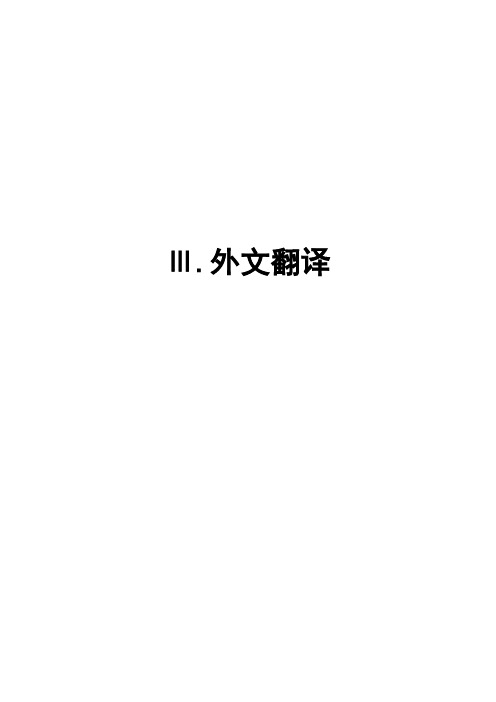
Ⅲ.外文翻译外文翻译之一Destination brand positions of a competitive set ofnear-home destinations作者:Steven Pike国籍:Australia出处:Tourism Management, In Press, Corrected Proof, Available online 24 January 2009原文正文:Abstract:Although the branding literature commenced during the 1940s, the first publications related to destination branding did not emerge until half a century later. A review of 74 destination branding publications by 102 authors from the first 10 years of destination branding literature (1998–2007) found at least nine potential research gaps warranting attention by researchers. In particular, there has been a lack of research examining the extent to which brand positioning campaigns have been successful in enhancing brand equity in the manner intended in the brand identity. The purpose of this paper is to report the results of an investigation of brand equity tracking for a competitive set of destinations in Queensland, Australia between 2003 and 2007. A hierarchy of consumer-based brand equity (CBBE) provided an effective means to monitor destination brand positions over time. A key implication of the results was the finding that there was no change in brand positions for any of the five destinations over the four year period. This leads to the proposition that destination position change within a competitive set will only occur slowly over a long period of time. The tabulation of 74 destination branding case studies, research papers, conceptual papers and web content analysesprovides students and researchers with a useful resource on the current state of the field.Keywords: Destination branding; Consumer-based brand equity; Short breaks; Destination image; Destination positioning1. IntroductionEver since the brand literature commenced in the 1940s (see for example Guest, 1942), there has been consistent recognition that branding offers organisations a means for differentiation in markets crowded with similar offerings ([Aaker, 1991], [Gardner and Levy, 1955], [Keller, 2003] and [Kotler et al., 2007]). For destinations, effective differentiation is critical given the increasingly competitive nature of tourism markets, where many places offering similar features are becoming substitutable (Pike, 2005). For example, around 70% of international travellers visit only 10 countries, leaving the remainder of national tourism offices (NTOs) competing for 30% of total international arrivals (Morgan, Pritchard, & Pride, 2002). The pursuit of differentiation is explicit in brand definitions, which have most commonly been variations of that proposed by Aaker (1991, p. 7):A brand is a distinguishing name and/or symbol (such as a logo, trademark, or package design) intended to identify the goods or services of either one seller or a group of sellers, and to differentiate those goods from those of competitors.However, in the foreword to the first issue of Place Branding and Public Policy, editor Simon Anholt (2004, p. 4) suggested “almost nobody agrees on what, ex actly, branding means” in describing place branding practice as akin to the Wild West. There has been a lack of consistency in defining what constitutes destination branding, both within industry and within academia (see [Blainet al., 2005], [Park and Petrick, 2006] and [Tasci and Kozak, 2006]). The mostcomprehensive definition to date has been that proposed by Blain et al. (2005, p. 337), which followed Berthon, Hulbert, and Pitt's (1999) model of the functions of a brand from both the buyer and seller perspectives:Destination branding is the set of marketing activities that (1) support the creation of a name, symbol, logo, word mark or other graphic that readily identifies and differentiates a destination; that (2) consistently convey the expectation of a memorable travel experience that is uniquely associated with the destination; that (3) serve to consolidate and reinforce the emotional connection between the visitor and the destination; and that (4) reduce consumer search costs and perceived risk. Collectively, these activities serve to create a destination image that positively influences consumer destination choice.Branding is therefore considered mutually beneficial from both the supply and demand perspectives. Enhancing the ability of the brand to differentiate effectively can generate advantages for products and services, such as increased purchase intent (Cobb-Walgren, Beal, & Donthu, 1995), lower costs (Keller, 1993), increased sales, price premiums, and customer loyalty ([Aaker, 1991] and [Aaker, 1996]). Advantages for destination marketing organisations (DMO) include increased potential to differentiate against places offering similar benefits, increased destination loyalty and increased yield for stakeholders such as local tourism businesses and travel intermediaries. Benefits for the traveller include ease of decision making through reduced search costs, reduced risk, and possibly enhanced brag value.The focus of most research reported to date has been concerned with the development of destination brand identities and the implementation of campaigns (see for example, [Crockett and Wood, 1999], [Hall, 1999], [May, 2001] and [Morgan et al., 2002]). One area requiring increased attention is that of tracking the performance of destination brand positions over time. That is,the extent to which destination brands' positioning and repositioning campaigns have been effective in enhancing brand equity consistent with that intended in the brand identity. This is an important gap in the tourism literature, given: i) increasing competition (see Morgan, Pritchard, & Piggot, 2002), ii) the increasing level of investment by destination marketing organisations (DMO) in branding since the 1990s, iii) the complex political nature of DMO brand decision making and increasing accountability to stakeholders (see Pike, 2005), and iv) the long-term nature of repositioning a destination's image in the marketplace (see Gartner & Hunt, 1987). In terms of metrics for DMOs in general, a number of researchers in various parts of the world have pointed to a lack of market research monitoring effectiveness of destination marketing objectives, such as in Australia (see [Carson et al., 2003] and [Prosser et al., 2000]), North America ([Masberg, 1999] and [Sheehan and Ritchie, 1997]), and Europe (Dolnicar & Schoesser, 2003).The aim of this study was to track the brand positions held by a competitive set of near-home destinations between 2003 and 2007. For this purpose the efficacy of a hierarchy of consumer-based brand equity (CBBE) was trialled. CBBE was first promoted by (Aaker, 1991) and (Aaker, 1996) and more recently by (Keller, 1993) and (Keller, 2003) to supplement traditional balance sheet brand equity measures. The rationale underpinning CBBE as a brand performance metric is that consumer perceptions of the brand underpin any financial estimate of future earnings estimated in the financial measure of brand equity. Since a financial balance sheet brand equity measure will be of little practical value to destination marketers, the concept of CBBE is worthy of consideration by DMOs. However, the potential of CBBE for destinations has only recently attracted the attention of academic researchers (see [Boo et al., in press] and [Konecknik and Gartner, 2007]).具有竞争力的靠近家乡的旅游目的地的目标品牌定位作者:史蒂文・派克国籍:澳大利亚出处:旅游管理,新闻,更正的证明,可在线2009年1月24日中文译文:摘要:虽然品牌学在20世纪40年代就已经兴起,第一个与目的地品牌相关的出版物却直到半个世纪后才出现。
旅游管理论文29718 高职旅游专业学生英语能力培养的有效途径研究
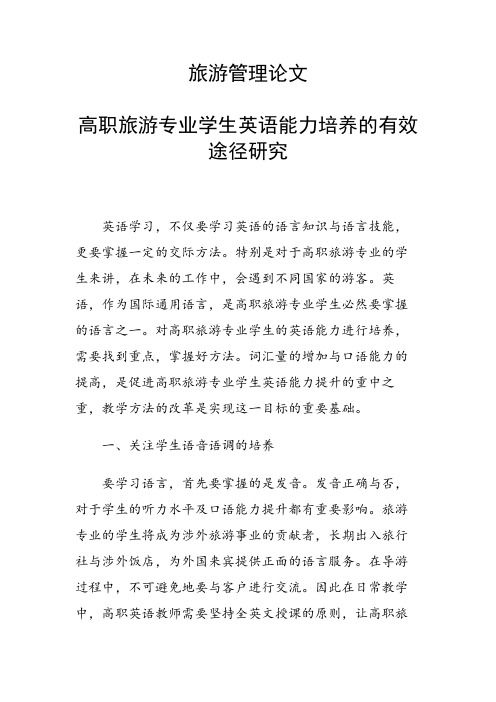
旅游管理论文高职旅游专业学生英语能力培养的有效途径研究英语学习,不仅要学习英语的语言知识与语言技能,更要掌握一定的交际方法。
特别是对于高职旅游专业的学生来讲,在未来的工作中,会遇到不同国家的游客。
英语,作为国际通用语言,是高职旅游专业学生必然要掌握的语言之一。
对高职旅游专业学生的英语能力进行培养,需要找到重点,掌握好方法。
词汇量的增加与口语能力的提高,是促进高职旅游专业学生英语能力提升的重中之重,教学方法的改革是实现这一目标的重要基础。
一、关注学生语音语调的培养要学习语言,首先要掌握的是发音。
发音正确与否,对于学生的听力水平及口语能力提升都有重要影响。
旅游专业的学生将成为涉外旅游事业的贡献者,长期出入旅行社与涉外饭店,为外国来宾提供正面的语言服务。
在导游过程中,不可避免地要与客户进行交流。
因此在日常教学中,高职英语教师需要坚持全英文授课的原则,让高职旅游专业学生在耳濡目染中掌握正确的英语发音与语音语调。
教师要明确英语发音的标准,通过科学有效的示范,让学生关注英语发音的动作与概念,正确区别易混淆的英语发音,促进旅游专业学生英语发音准确性的提高。
比如,对于英语中的咬舌音,教师需要引导学生进行反复练习。
中国学生在学习英语的过程中,经常会忽略咬舌音,造成其英语语音语调的不正确。
教师要培养学生良好的语音语调,就要从细节做起,引导学生发现英语语音中的区别之处。
二、加强专业英语词汇的积累词汇是英语学习的重要基础。
没有词汇,语言就是空洞的,人们不能完成最基本的对话与交流。
对于高职旅游专业的学生来讲,其词汇量不能仅仅满足日常交流,还需要掌握一些专业性的英语词汇。
在工作中,学生们需要利用英语对景点进行基本的介绍,如果不具有基本的英语词汇水平,是无法完成的。
旅游行业不同于其他行业,做旅游的人必须要具有丰富的知识面。
在进行景点的介绍时,要让游客们享受这次旅游,引人入境。
英语词汇的丰富,是高职旅游专业学生英语能力提高的重中之重。
旅游管理专业关于旅游资源的论文文献综述
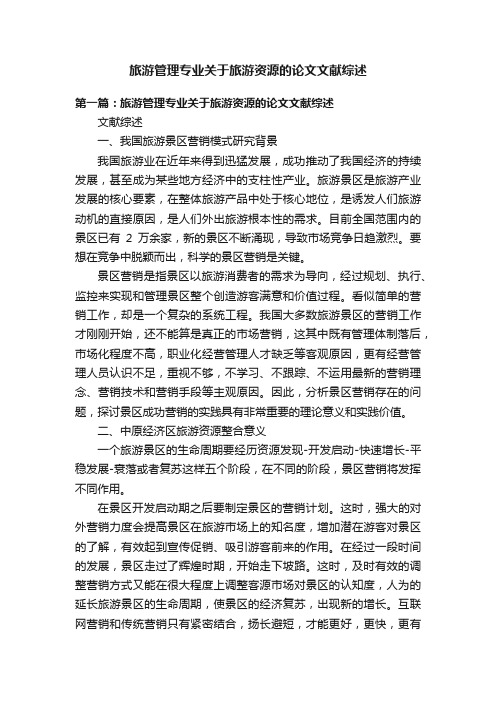
旅游管理专业关于旅游资源的论文文献综述第一篇:旅游管理专业关于旅游资源的论文文献综述文献综述一、我国旅游景区营销模式研究背景我国旅游业在近年来得到迅猛发展,成功推动了我国经济的持续发展,甚至成为某些地方经济中的支柱性产业。
旅游景区是旅游产业发展的核心要素,在整体旅游产品中处于核心地位,是诱发人们旅游动机的直接原因,是人们外出旅游根本性的需求。
目前全国范围内的景区已有2万余家,新的景区不断涌现,导致市场竞争日趋激烈。
要想在竞争中脱颖而出,科学的景区营销是关键。
景区营销是指景区以旅游消费者的需求为导向,经过规划、执行、监控来实现和管理景区整个创造游客满意和价值过程。
看似简单的营销工作,却是一个复杂的系统工程。
我国大多数旅游景区的营销工作才刚刚开始,还不能算是真正的市场营销,这其中既有管理体制落后,市场化程度不高,职业化经营管理人才缺乏等客观原因,更有经营管理人员认识不足,重视不够,不学习、不跟踪、不运用最新的营销理念、营销技术和营销手段等主观原因。
因此,分析景区营销存在的问题,探讨景区成功营销的实践具有非常重要的理论意义和实践价值。
二、中原经济区旅游资源整合意义一个旅游景区的生命周期要经历资源发现-开发启动-快速增长-平稳发展-衰落或者复苏这样五个阶段,在不同的阶段,景区营销将发挥不同作用。
在景区开发启动期之后要制定景区的营销计划。
这时,强大的对外营销力度会提高景区在旅游市场上的知名度,增加潜在游客对景区的了解,有效起到宣传促销、吸引游客前来的作用。
在经过一段时间的发展,景区走过了辉煌时期,开始走下坡路。
这时,及时有效的调整营销方式又能在很大程度上调整客源市场对景区的认知度,人为的延长旅游景区的生命周期,使景区的经济复苏,出现新的增长。
互联网营销和传统营销只有紧密结合,扬长避短,才能更好,更快,更有效率地满足顾客需要;旅游景区要想在旅游市场中取得优势, 就必须将自己的突出特色告知广大消费者, 并通过各种有效的营销手段牢牢抓住消费者, 让自己的产品占据一定的市场地位;在旅游景区的发展中, 营销人员是景区和旅游者关系的纽带。
《旅游管理开题报告文献综述》
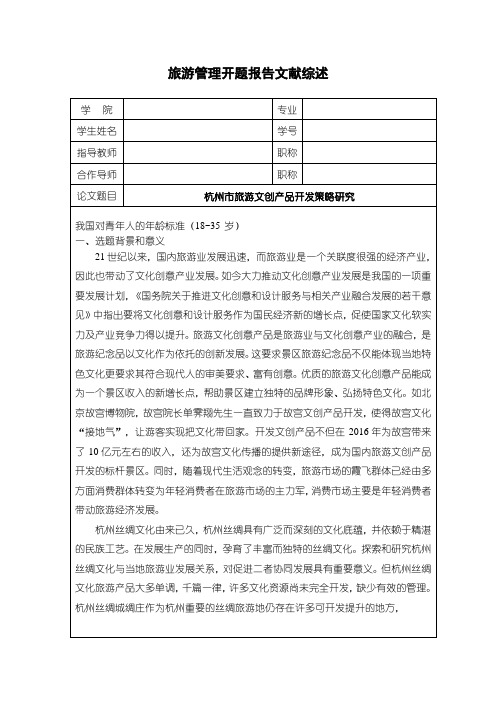
四、论文拟解决的关键问题及难点
第一,本文对相关概念及理论基础进行概述。
第二,对杭州丝绸旅游文创产品开发现状进行分析。
第三,对三、年轻消费者对杭州丝绸旅游文创产品的认知调研,并对调查结果进行分析之后提出对其产生影响的因子,影响年轻群体满意度的因素众多,各个因子的确定及分析是本文的研究难点。
第四,依据杭州的丝绸文化旅游资源和旅游产品的年轻群体偏好因素对杭州市丝绸文化旅游产品的体验性开发提出意见,旨在杭州文化旅游产品中系统性的展现古代文化,丰富产品内容,提高产品的市场竞争力。本文旨在结合当下宏观政策环境和市场调研的结果,通过对杭州市丝绸文化旅游产品的开发,把握好杭州作为丝绸之路起点城市以及文化古都的优势,为打造一个新的独具特色的智慧文化旅游中心做出理论贡献。
杭州丝绸文化由来已久,杭州丝绸具有广泛而深刻的文化底蕴,并依赖于精湛的民族工艺。在发展生产的同时,孕育了丰富而独特的丝绸文化。探索和研究杭州丝绸文化与当地旅游业发展关系,对促进二者协同发展具有重要意义。但杭州丝绸文化旅游产品大多单调,千篇一律,许多文化资源尚未完全开发,缺少有效的管理。杭州丝绸城绸庄作为杭州重要的丝绸旅游地仍存在许多可开发提升的地方,
旅游管理专业论文文献综述

文献综述在经过前三个时代即农业经济、工业经济和服务经济之后,体验经济时代悄悄地进入了人们的生活。
体验经济时代不同于前三个时代,他是一种复归经济,在这样的时代,人们对于旅游也有了不同的想法。
在现代社会中,随着工作竞争压力的加大,人们的压力也越来越大,人与人之间的关系也更加复杂,因此,旅游活动更加倍受青睐。
人们可以通过旅游来放松,实现自我的平衡。
旅游的本质是体验,这就意味着现代旅游业将成为体验经济时代的先锋。
传统的旅游方式已经满足不了现代人的需求,以感受和经历为主要目的的体验旅游逐渐受到大众的欢迎。
对我国来说,目前旅游业的发展已经取得了一定的成就,景区对于体验旅游产品的开发还不够成熟,尚处于起步阶段。
虽然起步较晚,但已引起学术界的广泛关注,国内外不少学者对于体验、体验经济、体验经济时代的体验旅游、体验旅游的涵义、类型、特点、作用以及体验旅游产品的开发等方面都作了探索性的研究。
一、关于体验定义研究关于体验的定义方面,美国管理专家约瑟夫.派恩和詹姆斯.吉尔摩两位认为,体验“是当一个人达到情绪、体力、智力甚至是精神的某一特定水平时,他意识中所产生的美好感觉。
” [1]根据孙明泉在《乡村体验与环都市乡村休闲》一书中的定义,“体验是消费者内在的心理感受,存在于每个人心中,是个人在形体,情绪,知识上的参与。
因为体验来自个人的心境与事件的互动,所以每个人的体验都是不同的”。
[2]二、关于体验经济研究对于体验经济,约瑟夫.派恩和詹姆斯.吉尔摩认为,体验经济是继农业经济、工业经济、服务经济这三个经济时代之后的第四个经济发展阶段,“体验经济是一种以服务为舞台,以商品为道具,以体验为主要经济提供物的经济形态。
”[3]在这两位专家的《体验经济》一书中,他们正式提出了“体验经济”一词的概念,从此也引起了众多学者的密切关注。
他们还在合作出版的《哈佛商业评论》中提出,体验经济时代已经到来。
美国另一位学者阿尔文.托夫勒在他的著作《未来冲击》中曾预言:“服务经济的下一步是走向体验经济,商家将靠提供这种体验服务取胜。
旅游管理专业文献综述

婺源文化旅游资源教育功能的开发研究文献综述专业:旅游管理班级:08级1班作者:胡小华指导老师:张春琴改革开放后,特别是近十几年,我国旅游业发展异军突起,蓬勃发展呈繁荣之势,在国民经济中占据着重要位置,文化旅游资源教育功能开发的研究也逐渐得到广泛关注。
本文将基于旅游学术界卷帙浩繁的相关文献 ,对近几年有关文化旅游资源教育功能开发的研究的成果进行归纳和评述。
笔者于2011年7月21 日以“文化旅游资源教育功能”为关键词,在中国知网数据库中进行检索 ,共查得相关文献36篇。
研究内容主要涉及旅游目的地文化旅游资源教育功能的开发模式、影响教育功能开发的因素、对教育功能开发水平的评价等三个方面。
一、文化旅游资源教育功能的开发模式文化是旅游的内核,文化旅游资源是是旅游资源的质,文化旅游资源具有旅游资源的共性,又具有不同的个性,在教育功能上,更多的是体现其个性的东西。
对于文化旅游资源教育功能的开发现状,重庆师范大学的李孝坤曾指出,文化旅游资源教育功能的开发主要依托两种模式,一是文化观光型模式,二是文化体验型模式。
首先提及的是文化观光型模式。
李孝坤在研究文章中提出,依托文化观光型模式开发文化旅游资源的教育功能,是教育功能开发的初级阶段,属于低层次。
由于这种模式当中的文化旅游资源类型单一,结构单一,内容单一,游客处在一个被动接受的位置,参与性欠缺,教育功能的发挥不尽如人意。
其次是文化体验型模式。
“依托文化体验型模式开发文化旅游资源的教育功能,是教育功能开发的高级阶段,也是未来的发展趋势,依托于这种模式,更加强调游客的参与度,游客由被动的接受转变到潜移默化的接受,文化旅游资源的教育功能也在无声中得到更大的发挥,颇有于无声处听惊雷的意思[1]。
”文化旅游资源教育功能的开发最重要的依托是旅游业的发展,文化旅游资源的的开发。
徐学书教授根据研究得出结论:“从我国旅游业发展的初衷来看,教育功能并不在旅游的职责范围之内,随着经济的快速发展,伴随着的却是道德体系的崩裂,旅游的教育功能才慢慢被提上议事日程,放置在旅游所必须承担的职责当中。
旅游管理与服务教育(师范)专业培养方案
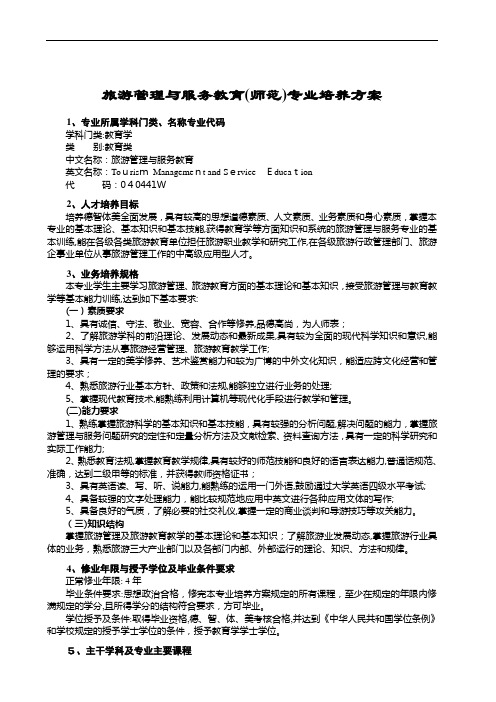
旅游管理与服务教育(师范)专业培养方案1、专业所属学科门类、名称专业代码学科门类:教育学类别:教育类中文名称:旅游管理与服务教育英文名称:TourismManagement and ServiceEducation代码:040441W2、人才培养目标培养德智体美全面发展,具有较高的思想道德素质、人文素质、业务素质和身心素质,掌握本专业的基本理论、基本知识和基本技能,获得教育学等方面知识和系统的旅游管理与服务专业的基本训练,能在各级各类旅游教育单位担任旅游职业教学和研究工作,在各级旅游行政管理部门、旅游企事业单位从事旅游管理工作的中高级应用型人才。
3、业务培养规格本专业学生主要学习旅游管理、旅游教育方面的基本理论和基本知识,接受旅游管理与教育教学等基本能力训练,达到如下基本要求:(一)素质要求1、具有诚信、守法、敬业、宽容、合作等修养,品德高尚,为人师表;2、了解旅游学科的前沿理论、发展动态和最新成果,具有较为全面的现代科学知识和意识,能够运用科学方法从事旅游经营管理、旅游教育教学工作;3、具有一定的美学修养、艺术鉴赏能力和较为广博的中外文化知识,能适应跨文化经营和管理的要求;4、熟悉旅游行业基本方针、政策和法规,能够独立进行业务的处理;5、掌握现代教育技术,能熟练利用计算机等现代化手段进行教学和管理。
(二)能力要求1、熟练掌握旅游科学的基本知识和基本技能,具有较强的分析问题,解决问题的能力,掌握旅游管理与服务问题研究的定性和定量分析方法及文献检索、资料查询方法,具有一定的科学研究和实际工作能力;2、熟悉教育法规,掌握教育教学规律,具有较好的师范技能和良好的语言表达能力,普通话规范、准确,达到二级甲等的标准,并获得教师资格证书;3、具有英语读、写、听、说能力,能熟练的运用一门外语,鼓励通过大学英语四级水平考试;4、具备较强的文字处理能力,能比较规范地应用中英文进行各种应用文体的写作;5、具备良好的气质,了解必要的社交礼仪,掌握一定的商业谈判和导游技巧等攻关能力。
旅游管理论文文献综述
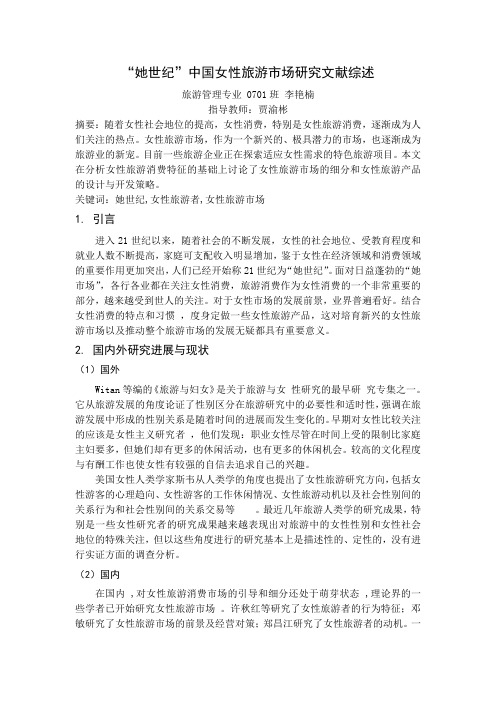
“她世纪”中国女性旅游市场研究文献综述旅游管理专业 0701班李艳楠指导教师:贾渝彬摘要:随着女性社会地位的提高,女性消费,特别是女性旅游消费,逐渐成为人们关注的热点。
女性旅游市场,作为一个新兴的、极具潜力的市场,也逐渐成为旅游业的新宠。
目前一些旅游企业正在探索适应女性需求的特色旅游项目。
本文在分析女性旅游消费特征的基础上讨论了女性旅游市场的细分和女性旅游产品的设计与开发策略。
关键词:她世纪,女性旅游者,女性旅游市场1.引言进入21世纪以来,随着社会的不断发展,女性的社会地位、受教育程度和就业人数不断提高,家庭可支配收入明显增加,鉴于女性在经济领域和消费领域的重要作用更加突出,人们已经开始称21世纪为“她世纪”。
面对日益蓬勃的“她市场”,各行各业都在关注女性消费,旅游消费作为女性消费的一个非常重要的部分,越来越受到世人的关注。
对于女性市场的发展前景,业界普遍看好。
结合女性消费的特点和习惯,度身定做一些女性旅游产品,这对培育新兴的女性旅游市场以及推动整个旅游市场的发展无疑都具有重要意义。
2.国内外研究进展与现状(1)国外Witan等编的《旅游与妇女》是关于旅游与女性研究的最早研究专集之一。
它从旅游发展的角度论证了性别区分在旅游研究中的必要性和适时性,强调在旅游发展中形成的性别关系是随着时间的进展而发生变化的。
早期对女性比较关注的应该是女性主义研究者,他们发现:职业女性尽管在时间上受的限制比家庭主妇要多,但她们却有更多的休闲活动,也有更多的休闲机会。
较高的文化程度与有酬工作也使女性有较强的自信去追求自己的兴趣。
美国女性人类学家斯韦从人类学的角度也提出了女性旅游研究方向,包括女性游客的心理趋向、女性游客的工作休闲情况、女性旅游动机以及社会性别间的关系行为和社会性别间的关系交易等。
最近几年旅游人类学的研究成果,特别是一些女性研究者的研究成果越来越表现出对旅游中的女性性别和女性社会地位的特殊关注,但以这些角度进行的研究基本上是描述性的、定性的,没有进行实证方面的调查分析。
《毕业论文》课程大纲

中国海洋大学本科生毕业论文课程大纲一、课程介绍1.课程描述:本课程为旅游管理专业本科学生必修课程。
学生在学习完本专业的所有课程后进行毕业论文的写作,此环节为本科学生学习的最后环节,不仅全面考核学生在校期间管理理论知识的学习状况,也考验学生的学术论文写作水平,还有助于进一步提高学生独立思考、独立分析、独立解决问题的能力,是学生毕业与学位资格认证的重要依据。
Graduation thesis is a compulsory course for tourism management undergraduate students.This course inspects students theoretical knowledge and the level of student papers.It can help students improve personal ability.Graduation thesis is the important basis of the qualification of Bachelor.This course is to guide students according to the requirements , grasping the writing process of graduation thesis. Completing the reply by teaching progress.Finally,school will entry scores on the basis of the achievement of the paper.2.设计思路:本课程引导学生根据学习要求,掌握毕业论文写作程序,选择论文题目并确定指导教师,撰写论文提纲、开题报告、任务书,根据大纲撰写初稿,最后根据指导教师意见,修改初稿,直至论文导师同意定稿。
按照教学进度完成答辩过程,最后依据考核方式及评价体系为学生毕业论文打分,最后录入成绩。
旅游管理专业论文外文文献翻译

外文资料译文及原文译文(一)消费者体验旅游和品牌的结合米契尔罗伯特定义消费者体验旅游制造工厂参观,公司博物馆和公司访客中心表现为被不同名字已知的观光事业片段:制造业观光事业,工业的吸引、工业的观光事业和工业的遗产观光事业。
在每一个描述性的长期的共同目标是在消费者学习品牌,其运作,生产过程,历史和历史意义的时候建立一个消费者和品牌之间的纽带。
有人建议在这里CET代表一个统一的主题的旅游。
这个术语捕捉消费者的消费能力发现更多关于他们所消费的品牌,而制造商可以在与该工厂的客人接触的30-120分钟时间里建立与这些消费者更密切的关系。
参与的品牌品牌经理寻求解决在三个层次消费者的需求:(1)功能(对消费者提供解决问题的办法);(2)符号(提供心理欲望满意度);(3)经历(提供感官快乐,品种,认知,刺激)CET可以通过视觉地介绍品牌,运作,生产工艺,历史和历史意义加强消费者和品牌之间的纽带。
这种纽带可以被看作是个人品牌参与和品牌忠诚度的提高。
认知参与反映了消费者对产品的兴趣(或学习更多)。
CET可以通过刺激消费者对于品牌和生产过程的想象提高消费者的认知水平。
此外,积极口碑沟通刺激满足旅客可能会比其他形式的促销更可信。
缺乏现有的直接研究关注迄今为止,CET已经在行销文学中受到一点注意。
米契尔和米契尔(2001年)对此内容这种的旅游网站进行了评估。
此外,这些相同的作者已经评估食物和饮料工业中的现象(米契尔和米契尔,2000年),非营利部门(米契尔和米契尔,2001年b),和整体经济(米契尔等, 2001)。
米契尔和米契尔(2002)为学者提出了格式,用来评估在当地的服务领域这些设施的地方利益。
该主题通常包括对整合营销的简要讨论,但已收到直接研究的关注很有限。
消费者体验旅游的多样性消费者体验旅游业是一群不同的旅游景点。
艾克斯罗德和布伦伯格(1997)配置了288工厂在整个美国欢迎参观者。
同样,伯杰和伯杰(1997年)提供约1,000自由工业旅游背景资料。
旅游管理毕业论文外文翻译
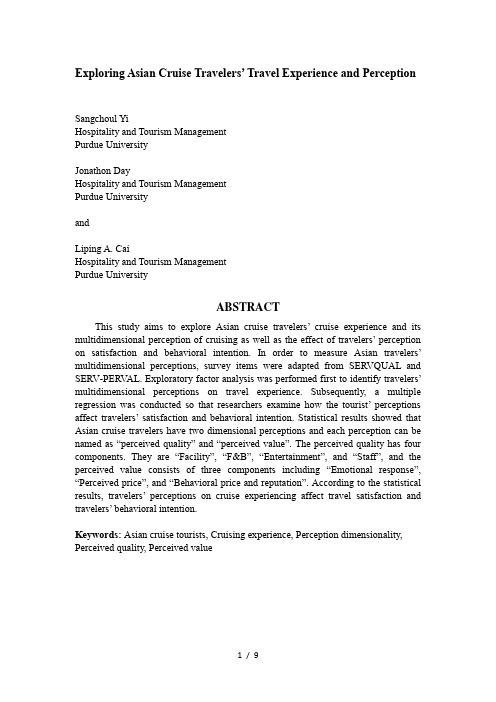
Exploring Asian Cruise Travelers’ Travel Experience and Perception Sangchoul YiHospitality and Tourism ManagementPurdue UniversityJonathon DayHospitality and Tourism ManagementPurdue UniversityandLiping A. CaiHospitality and Tourism ManagementPurdue UniversityABSTRACTThis study aims to explore Asian cruise travelers’ cruise experience and its multidimensional perception of cruising as well as the effect of travelers’ perception on satisfaction and behavioral intention. In order to measure Asian travelers’ multidimensional perceptions, survey items were adapted from SERVQUAL and SERV-PERV AL. Exploratory factor analysis was performed first to identify travelers’ multidimensional perceptions on travel experience. Subsequently, a multiple regression was conducted so that researchers examine how the tourist’ perceptions affect travelers’ satisfaction and behavioral intention. Statistical results showed that Asian cruise travelers have two dimensional perceptions and each perception can be named as “perceived quality” and “perceived value”. The perceived quality has four components. They are “Facility”, “F&B”, “Entertainment”, and “Staff”, and the perceived value consists of three components including “Emotional response”, “Perceived price”, and “Behavioral price and reputation”. According to the statistical results, travelers’ perceptions on cruise experiencing affect travel satisfaction and travelers’ behavioral intention.Keywords: Asian cruise tourists, Cruising experience, Perception dimensionality, Perceived quality, Perceived valueINTRODUCTIONThe cruise industry has been experiencing dramatic growth in the international tourism sector. According to the Cruise Line International Association (CLIA), its average growth rate is over 8% a year and the number of cruise passengers was 14 million in 2005, which was ten times more than that in 1980 (Dwyer & Forsyth, 1998; Kwag & Lee, 2009). With dramatic growth of the cruise industry, the market environment is getting competitive and appears to be saturated because of overcapacity (De la Vina & Ford, 2001; Kwortnik, 2006). This is because most of the cruise market is based upon North America and the regional market share accounts for 85% of the total cruise market. A strategic effort to occupy the competitive cruise market can be represented in the number of newly launched cruise ships because a quality stateroom, upscale cruise facilities, and stable room supply are essential for successful business in the cruise travel market, and these success factors can be achieved by launching new cruise vessel. For instance, major cruise liners have launched about 100 new cruise ships from 1996 to 2004, trying to attract potential customers, occupying a growing market share and developing new market segments (Lobo, 2008).Recently, the Asian cruise market has been highlighted as a new emerging market in the cruise industry. Currently, the Asian cruise market has 5% of total cruise market share, but the Asian cruise market has great potential as a new locomotive to sustain the cruise industry because a rise in national income in Asian countries can cause a dramatic increase of Asian cruise travelers. In East Asia, Hong Kong is a major hub for an international flight and international cruise liners. The city is attracting a number of western cruise travelers to Asia cruise travel, and Hong Kong is also a base for mainland Chinese cruise travelers. The number of the cruise travelers from Hong Kong alone 459,000 in 2007, which is more than double than from 201,000 in 2005 (Stanley, 2008). However, the Asian market has been still underdeveloped, and the market needs more investment and marketing research on the Asian market (Kwag &Lee, 2021).LITERATURE REVIEWThe tourism industry is service based industry, and the cruise travel and cruise ship itself can be viewed as a floating resort and tourism destination. Therefore, service quality issue is one of most important topics for cruise marketers because a good service quality and consumer’s satisfaction can guarantee business survival at least in the service industry. Consequently, the hospitality and tourism industry have focused on service quality improvement and customers’ satisfaction.Service qualityA great deal of service-quality studies have been done in last three decades, and most of topics have been center around efficient and accurate measurement of servicequality (Ladhari,2008; Martínez Caro & Martínez García, 2008). This is because measuring a service quality is a starting point to research consumers and consumers’ perception on service experience. In the service industry context, service quality can be viewed as perceived service quality and it can be defined as “ the consumer’s judgment about an entity’s overall excellence or superiority”(Parasuraman, Zeithaml, & Berry, 1988). Developed measurement instruments are mainly based on identified consumers’ perception on consumption experience. For example, Parasuraman et al. (1988) conducted the most influential studies on service quality, which was developing the SERVQUAL instrument. The SERVQUAL instrument had had ten perceived dimension, but Parasuraman et al. refined SERVQUAL measurement items, achieving five dimensions of perceived survey quality. The dimensions were labeled as “Tangibles”, “Reliability”, “Responsiveness”, “Assurance”, and “Empathy”. The instrument has become a foundation of service quality measurement instruments in various industry setting. One of distinct features is that the instrument compares between consumers’ expectation and realized performance of specific service. However, this approach has been challenged by some alternative measurement approaches.Service quality in the hospitality and tourism industryIn the hospitality and tourism industry, the perception of service quality has been widely researched and focused because it is imperative for marketers to know how consumers feel about service level in the hospitality and tourism industry. In order to measure consumers’ satisfaction and a perceived service quality, the SERVQUAL instrument has been introduced and modified in specific industry setting (Badri, Abdulla, & Al-Madani, 2005; Engelland, Workman, & Singh,2000; Frochot & Hughes, 2000; Khan, 2003; Knutson, Stevens, Wullaert, Patton, & Yokoyama,1991; Raajpoot, 2002; Stevens, Knutson, & Patton, 1995; Tkaczynski & Stokes, 2021). For example, Knuston et al. (1991) tailored the SERVQUAL into the lodging industry and generated LODGSERV instrument in order to measure consumers’ expectation for service quality in the lodging industry. Khan (2003) examined ecotourists’ the service quality expectation by using modified the SERVQUAL instrument, named as ECOSERV. It was found that tourists have unique a dimension in service quality expectation at each tourism industry setting. Stevens et al. (1995) and Raajpoot (2002) tried to measure consumers’ service quality in the lodging industry setting by modifying the SERVQUAL instrument. They generated modified versions of the instrument. DINESERV, which was generated by Stevens et al., was general version of the SERVQUAL in restaurants industry, and TANGSERV, which was proposed by Raajpoot, was focused on specific the SERVQUAL dimension, tangible quality.METHODOLOGYA questionnaire was developed based on previous empirical studies and SERV-PERV AL perceived value measurement instrument. The survey instrument consists of mainly four parts, which are perceived quality, perceived value, satisfaction level and behavioral intention, and demographic variables. This research extended the SERV-PERV AL instrument because the instrument has just four perceived quality items and they are too general to measure cruise travelers’ perception on cruise experience. Qu (1999) provided cruise travel attribute items, which consists of four dimensions such as “Accommodation”, “Food and Beverage”,“Entertainment”, “Other facility”, and “Staff”. Because the attribute items have uniqueness and similarity with SERVQUAL instrument at the same time, the attribute items were merged into SERV-PERV AL instrument.The sample was collected from cruise travelers of a Korean cruise liner. The convenience sampling was chosen because of time and cost limitations. Two trained interviewers visited a medium sized cruise ship, the Penstar Honey, and distributed questionnaires. Questionnaires were placed in 200 cruise ship cabins. After respondents completed the survey voluntarily, the questionnaire were gathered at the reception desk of the cruise ship. A total of 140 questionnaires were collected between May and June in 2008. Participants were sampled on eight separate 3-day and 4-day voyages with various destinations such as the Korean national marine park, Osaka in Japan and Bebu, which is a famous Japanese spa destination. The samples yielded 117 usable observations.An exploratory factor analysis was first performed so that underlying dimensions of each construct were revealed. Based results of exploratory factor analysis on each construct like perceived quality and perceived value, four perceived quality dimension were identified and three perceived value dimensions were obtained. These sub-dimensions of perceived quality and value composed overall perceived quality and value construct for cruise travel. SPSS version 18 and STATA 10 were used to conduct exploratory factor analysis and regression analysis to examine the relationship between hypothetical relationships between constructs.RESULTSAccording to the factor analysis results in Table 1, perceived quality has four dimensions including cruise ship facilities, food and beverage service, entertainment, and crew’s service. Perceived value consists of three dimensions such as emotional response, perceived price, and behavioral price and reputation. Each construct has sub dimensions, which means that cruise tourists recognize their cruising experience based on four dimensions like facilities, food and beverage, entertainment, and staff as well as the tourists value their experience by two constructs perceived quality and perceived value.Table 1Exploratory Factor Analysis Results for Perceived Quality of the Cruise ExperienceSub-dimensions of two constructs are measured by multiple survey items. Exploratory factor analysis provides construct reliability for determining whether survey items are suitable for measuring the sub dimensions and constructs. Items with factors loading are less than .5 were eliminated to refine survey measurement items. Mean value of each survey items represent cruise tourism service quality index, and most of the means recorded higher than 5, indicating high quality of cruise service experience. Results can show that cruise tourists are more likely to have positive cognitive image on cruise experience and cruise ship brand.In Table 2, it was showed that perceived value construct has three dimensions including emotional response, perceived price, and behavioral price and reputation. Petrick (2004) suggested that the perceived value construct has five dimenstions, which included perceived quality as a part of the construct. However, in this study, researchers specified perceived quality as independent part of the construct when the perceived quality was measured because a survey instrument was developed to measure service quality more specifically than original SERVPERV AL instrument.CONCLUSIONThis study aims to explore Asian cruise travelers’ cruise experience and its multidimensional perceptions of cruising experience as well as the effect of travelers’ perceptions on satisfaction and behavioral intention. In order to measure Asian travelers’ multidimensional perceptions,survey items were adapted from previous empirical study, the SERVQUAL instruments and the SERV-PERVAL instrument item. An on-board survey was conducted on eight separate 4-days voyages of the Far East Asia in 2008. Exploratory factor analysis was performed first to identify travelers’ multidimensional perceptions on travel experience and service quality in cruise travle. Subsequently, a regression analysis was conducted so that researchers examine how the travelers’perception of cruise travel experience affects tourists’ satisfaction and behavioral intention.对旅游者旅游体验感知的探索——以亚洲邮轮游客为例Sangchoul Yi,Jonathon Day,Liping A. Cai,酒店与旅游办理专业,美国普渡大学。
旅游管理本科专业实践教学文献综述-推荐下载
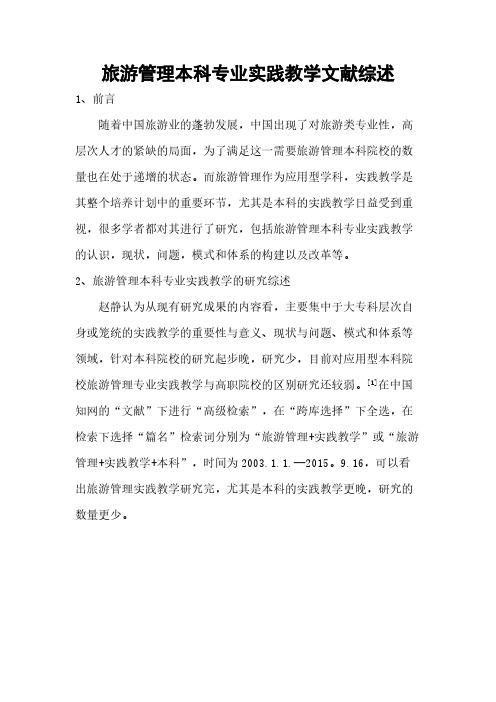
旅游管理本科专业实践教学文献综述1、前言随着中国旅游业的蓬勃发展,中国出现了对旅游类专业性,高层次人才的紧缺的局面,为了满足这一需要旅游管理本科院校的数量也在处于递增的状态。
而旅游管理作为应用型学科,实践教学是其整个培养计划中的重要环节,尤其是本科的实践教学日益受到重视,很多学者都对其进行了研究,包括旅游管理本科专业实践教学的认识,现状,问题,模式和体系的构建以及改革等。
2、旅游管理本科专业实践教学的研究综述赵静认为从现有研究成果的内容看,主要集中于大专科层次自身或笼统的实践教学的重要性与意义、现状与问题、模式和体系等领域,针对本科院校的研究起步晚,研究少,目前对应用型本科院校旅游管理专业实践教学与高职院校的区别研究还较弱。
[1]在中国知网的“文献”下进行“高级检索”,在“跨库选择”下全选,在检索下选择“篇名”检索词分别为“旅游管理+实践教学”或“旅游管理+实践教学+本科”,时间为2003.1.1.--2015。
9.16,可以看出旅游管理实践教学研究完,尤其是本科的实践教学更晚,研究的数量更少。
以及创新能力,让学生能够很快的适应旅游行业的发展需要。
[4]教育部认为旅游管理本科专业实践教学主要包括实验、实习、实训、社会实践、毕业设计等环节,旅游行业的调查和旅游业务实习是其中的主要环节。
[5]孟丽等认为旅游管理专业实践教学设计是以学习应用型本科大学定位为基础,以构建实用性强、具有创新精神和实践能力的旅游人才为目标来进行的。
[6]王全在认为旅游管理实践教学的作用为实践教学是理论教学的价值体现,实践教学是培养现代旅游人才的需要,实践教学是培养学生良好职业道德的需要,实践教学是实现校企合作的重要途径。
[7]4、旅游管理本科专业实践教学的问题研究综述(1)培养目标不明确赵静认为地方本科院校在旅游管理专业人才培养目标定位不准,实践教学方向摇摆。
[1]龚艳认为大部分本科院校旅游管理专业存在着培养目标不明确,专业不专,优势不优的问题,在人才培养中重理论轻实践,强调学科性、理论性、完整性和系统性,而忽视了学生专业能力的实践性和职业素质的养成性教育。
旅游管理毕业论文试析旅游资料汉译英应把握的几个基本要求论文
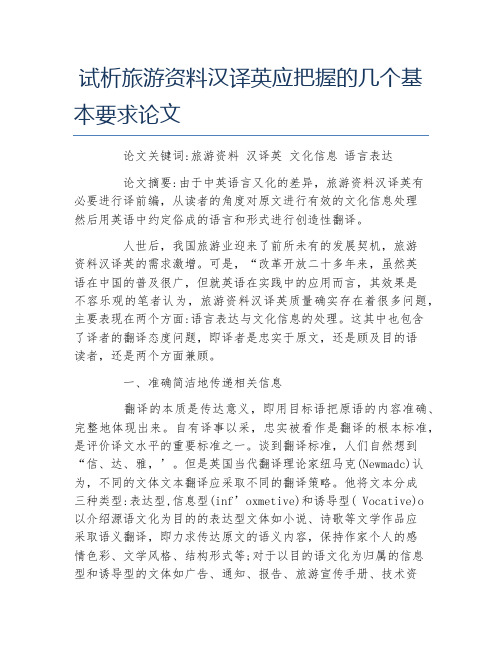
试析旅游资料汉译英应把握的几个基本要求论文论文关键词:旅游资料汉译英文化信息语言表达论文摘要:由于中英语言又化的差异,旅游资料汉译英有必要进行译前编,从读者的角度对原文进行有效的文化信息处理然后用英语中约定俗成的语言和形式进行创造性翻译。
人世后,我国旅游业迎来了前所未有的发展契机,旅游资料汉译英的需求激增。
可是,“改革开放二十多年来,虽然英语在中国的普及很广,但就英语在实践中的应用而言,其效果是不容乐观的笔者认为,旅游资料汉译英质量确实存在着很多问题,主要表现在两个方面:语言表达与文化信息的处理。
这其中也包含了译者的翻译态度问题,即译者是忠实于原文,还是顾及目的语读者,还是两个方面兼顾。
一、准确简洁地传递相关信息翻译的本质是传达意义,即用目标语把原语的内容准确、完整地体现出来。
自有译事以采,忠实被看作是翻译的根本标准,是评价译文水平的重要标准之一。
谈到翻译标准,人们自然想到“信、达、雅,’。
但是英国当代翻译理论家纽马克(Newmadc)认为,不同的文体文本翻译应采取不同的翻译策略。
他将文本分成三种类型:表达型,信息型(inf’oxmetive)和诱导型( Vocative)o以介绍源语文化为目的的表达型文体如小说、诗歌等文学作品应采取语义翻译,即力求传达原文的语义内容,保持作家个人的感情色彩、文学风格、结构形式等;对于以目的语文化为归属的信息型和诱导型的文体如广告、通知、报告、旅游宣传手册、技术资料等应采取交际翻译方法,注重读者的理解和反应,在表达方式、格式、措辞等方面应尽可能符合该文体在译人语中的习惯(Newmark, 1988)。
因此,中文旅游资料英译有自身的特殊性,不是本着忠实准确的原则字字对应直译了事那么简单。
如果谋求英语译文在表面形式上与汉语原文一致,必然会导致译文受者不能接受的语义重复、结构臃肿以及逻辑馄乱。
中文旅游资料英译应以目的语为归宿,从译文受者的角度出发,用英语中约定俗成的语言和形式进行创造性翻译,对原文本进行译前编,设法化解由文化、社会背景、逻辑思维、审美观等方面的差异带来的理解困难,使译文受者在摄取信息的过程中不会遇到障碍。
旅游服务与管理专业学术论文(蒲世民)
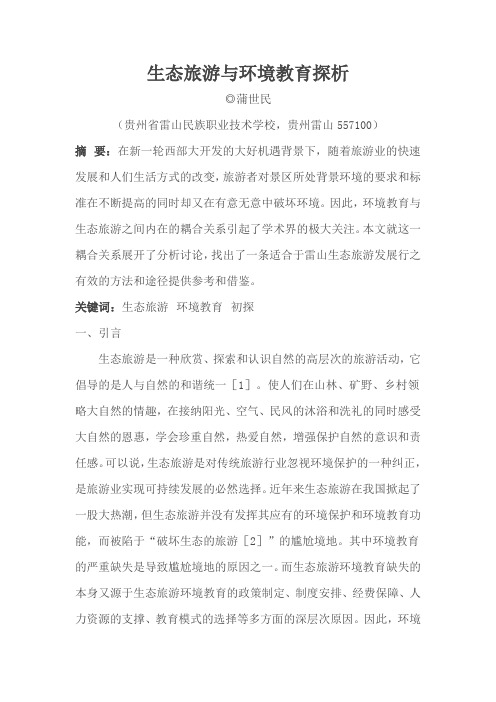
生态旅游与环境教育探析◎蒲世民(贵州省雷山民族职业技术学校,贵州雷山557100)摘要:在新一轮西部大开发的大好机遇背景下,随着旅游业的快速发展和人们生活方式的改变,旅游者对景区所处背景环境的要求和标准在不断提高的同时却又在有意无意中破坏环境。
因此,环境教育与生态旅游之间内在的耦合关系引起了学术界的极大关注。
本文就这一耦合关系展开了分析讨论,找出了一条适合于雷山生态旅游发展行之有效的方法和途径提供参考和借鉴。
关键词:生态旅游环境教育初探一、引言生态旅游是一种欣赏、探索和认识自然的高层次的旅游活动,它倡导的是人与自然的和谐统一[1]。
使人们在山林、矿野、乡村领略大自然的情趣,在接纳阳光、空气、民风的沐浴和洗礼的同时感受大自然的恩惠,学会珍重自然,热爱自然,增强保护自然的意识和责任感。
可以说,生态旅游是对传统旅游行业忽视环境保护的一种纠正,是旅游业实现可持续发展的必然选择。
近年来生态旅游在我国掀起了一股大热潮,但生态旅游并没有发挥其应有的环境保护和环境教育功能,而被陷于“破坏生态的旅游[2]”的尴尬境地。
其中环境教育的严重缺失是导致尴尬境地的原因之一。
而生态旅游环境教育缺失的本身又源于生态旅游环境教育的政策制定、制度安排、经费保障、人力资源的支撑、教育模式的选择等多方面的深层次原因。
因此,环境教育与生态旅游之间内在的耦合关系引起了学术界的极大关注。
其实,在国外真正的生态旅游有三个重要方面:一是生态旅游者基于回归自然的旅游动机和需求进行所谓的“自然旅游”或“绿色旅游”,实则是生态旅游作为一种旅游方式实现人们的自然旅游目的;二是对生态旅游者的自身素质要求高,在国外真正从事生态旅游者的人都是具有强烈环保意识的人士,他们多来自各种与环保直接或间接相关的协会或俱乐部,并志同道合地组织开展生态旅游,实现第一方面目的的同时为旅游目的地的环境保护事业做贡献,以他们的实际行动呼吁全社会关注人与自然的协调发展,这是国外真正开展生态旅游的目的所在;三是当生态旅游作为一种产业带去支持和发展时,便使生态旅游具有了一种经济属性,要求能通过生态旅游的科学发展实现旅游目的地的产业结构调整和经济社会发展,其目的是将环境资源转化成社会效益、经济效益和环境效益,实现当地居民可持续创汇的目的。
旅游管理专业文献综述
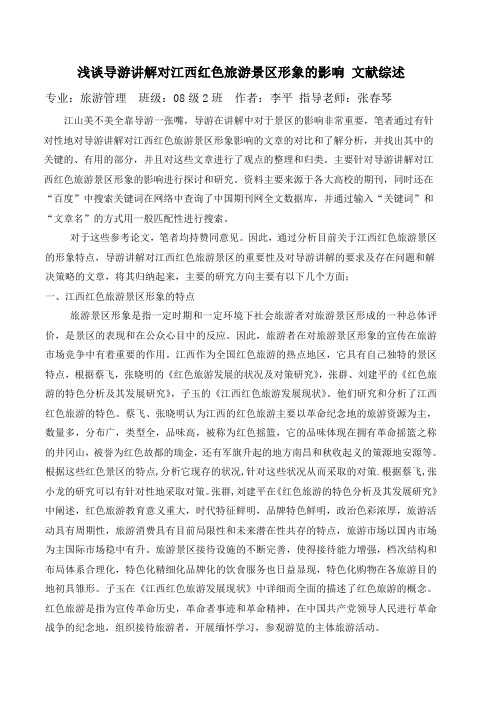
浅谈导游讲解对江西红色旅游景区形象的影响文献综述专业:旅游管理班级:08级2班作者:李平指导老师:张春琴江山美不美全靠导游一张嘴,导游在讲解中对于景区的影响非常重要,笔者通过有针对性地对导游讲解对江西红色旅游景区形象影响的文章的对比和了解分析,并找出其中的关键的、有用的部分,并且对这些文章进行了观点的整理和归类。
主要针对导游讲解对江西红色旅游景区形象的影响进行探讨和研究。
资料主要来源于各大高校的期刊,同时还在“百度”中搜索关键词在网络中查询了中国期刊网全文数据库,并通过输入“关键词”和“文章名”的方式用一般匹配性进行搜索。
对于这些参考论文,笔者均持赞同意见。
因此,通过分析目前关于江西红色旅游景区的形象特点,导游讲解对江西红色旅游景区的重要性及对导游讲解的要求及存在问题和解决策略的文章,将其归纳起来,主要的研究方向主要有以下几个方面;一、江西红色旅游景区形象的特点旅游景区形象是指一定时期和一定环境下社会旅游者对旅游景区形成的一种总体评价,是景区的表现和在公众心目中的反应。
因此,旅游者在对旅游景区形象的宣传在旅游市场竞争中有着重要的作用。
江西作为全国红色旅游的热点地区,它具有自己独特的景区特点,根据蔡飞,张晓明的《红色旅游发展的状况及对策研究》,张群、刘建平的《红色旅游的特色分析及其发展研究》,子玉的《江西红色旅游发展现状》。
他们研究和分析了江西红色旅游的特色。
蔡飞、张晓明认为江西的红色旅游主要以革命纪念地的旅游资源为主,数量多,分布广,类型全,品味高,被称为红色摇篮,它的品味体现在拥有革命摇篮之称的井冈山,被誉为红色故都的瑞金,还有军旗升起的地方南昌和秋收起义的策源地安源等。
根据这些红色景区的特点,分析它现存的状况,针对这些状况从而采取的对策.根据蔡飞,张小龙的研究可以有针对性地采取对策。
张群,刘建平在《红色旅游的特色分析及其发展研究》中阐述,红色旅游教育意义重大,时代特征鲜明,品牌特色鲜明,政治色彩浓厚,旅游活动具有周期性,旅游消费具有目前局限性和未来潜在性共存的特点,旅游市场以国内市场为主国际市场稳中有升。
- 1、下载文档前请自行甄别文档内容的完整性,平台不提供额外的编辑、内容补充、找答案等附加服务。
- 2、"仅部分预览"的文档,不可在线预览部分如存在完整性等问题,可反馈申请退款(可完整预览的文档不适用该条件!)。
- 3、如文档侵犯您的权益,请联系客服反馈,我们会尽快为您处理(人工客服工作时间:9:00-18:30)。
旅游管理与服务教育中英文资料对照外文翻译文献综述Discuss tourist guide's cultivating of synthetical ability It is a systematic learning that tourist guide works really , also is an artistic it with artificial , is said to work behaving in certain meaning . No matter being in the travel service , all negative having the special duty in tour round and the society to hold in both hands by man of letters therefore enjoying the special position rivers and mountains , the beautiful scenery will blow by tourist guide . Like that travel service gives rise to surely chiefly product _ tour circuit , and chiefly cause tourist guide accomplishes its sale course , does not have the tour corps of tourist guide not to have soul vividly deciding by role circle yet , the duty by the expectation decision conducts a sightseeing tour work Ren Daoer weight far awayThe synthetical character and the ability of tourist guide person self are to the factor that can directly influence the service quality of belt round conducting a sightseeing tour , and whether it can also be at the same time being the key tourist guide personnel that good tourist guide received work over a long period of time excluded taking charge of a department , and the thousands of strands and loose ends will be monoplized , and the square aspect face will be dealed with , and the unexpected affair will be decided quickly , and the special requirement will be tried satisfiedly . Facing this does not all sorts ofly has good synthetical character and ability why can deal with free again Only constantly make perfect selfhood , and cultivates the outstanding synthetical ability , and can open up the tourist industry that our homeland is fine and magnificentOne tourist guide personnel should have synthetical character and ability : Tourist guide is praised the face and mirror of nation , and does not have crown ambassador and minister of foreign affairs , and tourist guide should be it enjoying popular confidence visitor of visitor places on the great expectations to tourist guide , and the at the same time also is the ridge beam of travel service . The service concentration of travel service embodies in the action conducting a sightseeing tour , and the image of travel service firstly will be modeled by tourist guide .Is not that but to be better than manager is not that the promoting sales person but is better than the promoting sales person to manager . The great expectations is placed on in the society , and exchanges to help to bring about by tourist guide because the propagation will be conducted a sightseeing tour to civilization economy . The image conducting a sightseeing tour is that the image of enterprise also is the image of nation . It goes without saying to the important meaning that touristguide works . Spirit that the conduct a sightseeing tour work will embody " with artificial " only has the making a good job of conducting a sightseeing tour serving of high quality of good entire character ability . Therefore , since modern times one kind of service tourist guide is again a specialty and art .Qualified a tourist guide personnel firstly should have the consciousness serving , serve technical ability and also should possess at the same time the standard and the ability of preformer directed . Therefore should have good synthetical character and abilityThe 1 thought advance , the moral character noble in any times any nation , the moral character of person always is in the most important position , and firstly ardently loves the homeland as the tourist guide person . The basic content conducted a sightseeing tour to explain is the beautiful rivers and mountains introduce the homeland to tour person , the civilization of long history and magnificent . The tourist guide person not only will be explained , and real situation true feeling will work hard for with self is gone to influence visitor and is made his give rise to and cry altogether , when speech a row leaveeing the fine impression tourist guide person all is closely linked with the honour or disgrace of homeland , and the image of tourist industry that it is fought is closely linked , if therefore the tourist guide person is not ardently loved the homeland , the political consciousness of support socialism system can not do good tourist guide and work Conduct a sightseeing tour work also is at the same time a window of nation open policy , and conducting a sightseeing tour that it is strong to translate work policy , the influence face is big , therefore must set up the legal system concept highly as tourist guide person , strictly abiding by the discipline abiding by the law , political position is firm , and observes strictly the state secret , and keeps firmly in mind the principle " keeping inside information from outsiders " .Tourist guide works the propagation civilization , and promoting the friendship , the tourist guide person will be ardently loved job work , pours into enthusiasm , the service that the person who spares no pains provided the high quality for coming from the friends of all corners of the land genuinely is accomplished " within the four seas bosom friend deposits , the end of the world if near "2 do desultory reading extensively , and that overall modern times tour activity of knowledge is not merely amuse self and view and admire . A person travelling still needs to procure information at pastime surplus and haves a taste of the foreign country sentiment to increase knowledge and enlarges experience . The practice proves , and to explain colloquizeing with day-to-day is the major source of the person's travelling capturing knowledge to tourist guide person . For this kind of needs that suit visitor , the tourist guide personnel knowledge face is to be wide and will have the real ability and learning , and takes broad and profound knowledge as the backing , and do to the content enriching and speech the has thingThe knowledge of tourist guide person chiefly includes : The journey common sense of language and history ground civilization and policy regulations , psychology , aesthetics , society knowledge and basic . Can be spoken , tourist guide is " Eclectics " album various kind of knowledgein digesing , one set of formation possesses self tourist guide's style of characteristic , and the form that is not fixed admittedly is nimble changeable .Eloquence conducting a sightseeing tour be the humour , and sharp , the reaction is alert and resourceful nimble .Conducting a sightseeing tour , personnel constantly make perfect selfhood in the course of belt round , open-minded studys , " to collect hundred long , mends self short " raising the service level kimono affair quality , and do to the service only starting point , the terminal point is not had in the satisfaction3 are good at coordinating being rich in innovation tourist industry affair scope extensively , and the correlation vocational work that involves is fairly more complicated , and as for tourist guide personnel , the spirit to solve the ability of problem and innovation looks outstanding and attache s most importance to to wanting the autonomous working ability . Tourist guide person will stand alone make the decision after accepting the assignment , and the person who will take charge of a department organisation tour person visits that the sight-seeing moves about to the independent handle problem , will make that the whole tour round sight-seeing is good and lives well , so requirement tourist guide has stronger ability meeting an emergency , the organisation coordinates the ability , nimble adopts effective the measure , is good at watching a person's every mood understands the trends of tour person , so better for visitor serves.It is very important that adept as for tourists guide the tourist guide's technical ability of spirit is realized and keeps forging ahead in the competition , and that broad and profound knowledge not represents has very high tourist guide's technical ability , and tourist guide's technical ability chiefly is intelligence technical ability , and namelys tourist guide person should arrange visits the ability of programme according to the true state of affairs science ingeniouslyly to 4 higher tourist guide's technical ability , the elegant tourist guide person of one famous-brand should possess the command man the standard , namely also will have the ability of preformer , and will have the ability to transfer the zeal of the person travelling at any time , delight that makes them gains travel together in perfect harmony good is enjoyed , and will have the rich knowledge of the control can skillfully used , humour the language , the fascinating explains the person travelling conquering to the intonation of cadence , makes they immerses appreciates beautiful in joyful .Kimono affair technical ability is three basic essential factors of tourist guide service to knowledge to the language , integral , only three the harmonious combination is worthy to be called tourist guide's who is high quality service . The service technical ability of tourist guide person and knowledge grasped have the very big relation , and needing to cultivate and develops in the practice , the summary not breaking is perfect .The mentality character of 5 healthy bodies and good is conducted a sightseeing tour , and the work is one high intelligent service work , since a mental work is a physical labor again . Its work load is big and the face is wide , and mobility and repeatability have strongly been put forward the higher requirement as for the condition of body , otherwise very hard suits .The good mentality character works the necessity very to tourist guide to the characteristicbecause travelling to move about , and the tourist guide person is one full of vim and vigour forever , and the mood is fully , and the frame of mind is happy , and the brains is soberly , the quick-witted nimble each side making a good job of of ability relation , the person of very strong certainly accuse ability possesses . Can point out that tourist guide person is it is quick-witted to collect specialty technical ability and knowledge , and is seasoned in smooth and evasive the person all over the body in tour expert's handkerchief of Canada is special .Tourist guide is the nation , travel service and spokesman of enterprise , and the words and deeds bearings all will be judge travelling the whether successful key of service , and the reputation that the more important is good has only had the good character ability to the beneficial result that what brings far is incessantly , in working constantly the effort seeks , good tour worker who is really straight , does not have one states unchangeable the reason , develops in the change develops , it also is in constantly study and advance that tourist guide ability is had Two , the synthetical ability aspect of tourist guide exists the defect reaching and tourist guide explains the defect of ability aspect :The language conducting a sightseeing tour is rated as second scenery traveled , and visitor is by way of brilliant tourist guide's language , can increase quality visiting , and deepen the impression going sightseeing , and lightens the tired and lonely that travels , and the strong human touch that many knowledge are affected by the where guests feel at home that the understanding in the area at scenery scenic spot can not seen . Thus leave the fine profoundly memory . To with tourist guide , speaking should be no problem , can in taking to roll into a ball the course explanation standard of tourist guide person and each other going very far . The linguistic description ability is strong and weak in the time of a lot , and what the various subject matter that has difference same of the method of tourist guide can appear differently even to the extent that can appear the contrary fruit .Now the problem that universally exists has : 1. Some tourist guide person knowledge standards are inadequate , can memorize mechanically that some tourist guides read item by item from the text by the word , seemingly Buddhist monk recites scriptures , prosaiclly , and " one side Bai Bing , no matter treating equally without discrimination " differing in thousands of ways , the word explaining of tourist guide is stereotyped 2. Some tourist guide persons only can be used the dry and dull dry insipid language , several inflexible numerals are introduced the tour sight spot . Other visitor is drowsy and has no new meaning and speech 3. But half solutions at the sight spot to introduce of some tourist guide persons often in a few words , being muddled through the work , and only having acted to lead and the simple effect explaind , and the enquirement to visitor also is saying "I don't know" to every question , and intimate awkward visitor is unhappily 4. Some items indulge in exaggeration , it is utter lack of substance , even to the extent that confuses one thing with antoher the historical facts fabricated , and being devoid of substance after letting person listen ( two ) and the tourist guide takes to roll into a ball the defect of ability aspect : Conducting a sightseeing tour the belt round technical ability of personnel , being guiding the whole according to the touring party of visitor person to need few needs with different visitors , the skilled applicationcan raise product use value and method and skill and the ability travelling .It is very wide to conduct a sightseeing tour in the course of the service of personnel provides the contact for visitor , need to cultivate selfhood management ability reaching handle well and travel service , visitor the leade of a group , driver reaches other host organizations and the cooperation of personnel relation . But few a few individuals of a tour corps , but high and low in a belt round sight-seeing visiting and conducting a sightseeing tour work is taking to coordinate linking up many tens person tens person tourist guide person , inside and outside , the important effect about .If tourist guide person lets things drift , lacking strength to drive the travelling round , and not only can not accomplish tourist guide's assignment , and occur easily to conduct a sightseeing tour that effect is wrongs , and leak the view , and visitor loses to wait for the accident , and how a tour round intersection takes the person being hospitable by tourist guide person commands the tourist guide person , and lets visitor obey the arrangement of self , and this involves the problem with technical ability of ability wisdom.It is wrong that now some tourist guide persons universally exists the belt round ability , and can not obey manyly , and bring the loss to the travel service , or causes that visitor discontent chiefly has following several causes : 1. not setting up the good image , the tourist guide person first time and visitor contact , and the good or bad of first impression certainly will influence later on the belt round serving .Owing to the fact that modern tourist guide's newly emerging force is multitudinous .One part source and society put on therefore can appear Nong Zhuanyan , and the occasion is indisposedly answered by the clothing , and noisy soldier takes by force the appearance such as owner etc should to have been appeared with the good looks appearance bearing as tourist guide person , and all will influence the mentality mood of visitor , so work on foundation is certainly will do well .Harmonious surrounding feeling and tour person build partner's relation 2. can not create . The person travelling not only is the customer of tourist guide person , and also is the cooperation relation of tourist guide person , and only both sides make a concerted effort to travel , and the work can be in progress and achieve expected good effect smoothly . Sincerity is exchanged in the sincerity , and your support will exchange visitor is sincerely understood and is cooperated . Even the small interlude that because of all sorts of causes occurs in the journey , can be because of your true-hearted manner , what spends in the heart the solution visitor is unhappy to the thoughtful service of enthusiasm . Otherwise the result is you can imagine . All effortizations that you do are for the bubble , and also can influence the reputation of travel service at this point.导游全方位能力的培养导游是一门学问,也是一门艺术。
